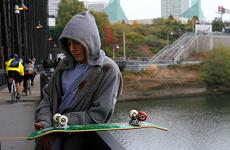
 |
| Photo © 2007 IFC Films/MK2 Productions |
| Cannes Film Festival (2007): 60th Anniversary Prize | |
| Boston Society of Film Critics: Best Director (Van Sant; also cited for Milk); Best Cinematography (Christopher Doyle and Rain Kathy Li) |
| Permalink | Home | 2008 | ABC | Blog |